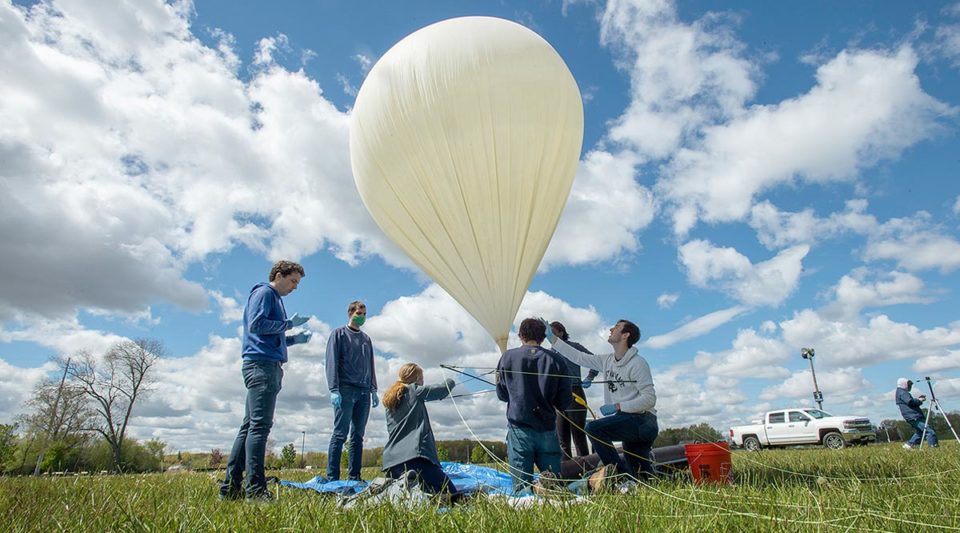Notre Dame students and faculty gathered on May 11, 2021, for the first high-altitude balloon launch by IrishSat, a new student-run satellite development group.
A team of well-trained students attached payloads containing research projects to a weather balloon filled with helium, then released the balloon to rise approximately 115,000 feet (35 kilometers) in the air, until the balloon burst and the payload drifted safely to the ground attached to a 7-foot parachute.
IrishSat focuses on developing CubeSats and other satellite related hardware. CubeSats are research-based nanosatellites, approximately 4” square, which carry research into space through NASA’s CubeSat Launch Initiative. The initiative is a means for researchers to expand and test their work in space while introducing students to satellite technology and space exploration.
The Notre Dame design team, which features students from aerospace engineering, electrical engineering, computer science and engineering, physics, and marketing and finance, worked with faculty to develop a CubeSat and a “FlatSat” payload to carry multiple projects on the balloon.
In addition to designing and building the nanosatellites and the balloon, the students developed a sensor to study clouds and air moisture, obtained the required radio licenses for the launch, and worked with the Federal Aviation Association for flight clearance.

“We created IrishSat to give Notre Dame students the opportunity to explore the space industry and gain real-world experience,” said club co-founder Will Karpick, IrishSat project manager and junior pursuing a degree in aerospace engineering.
Owen Kranz, a junior aerospace engineering major who serves as the team’s chief engineer, says the main lesson he’s taken from the experience is one of the value of bringing talented people together to accomplish something greater than their individual skills. “I’ve learned how powerful teamwork can be,” he said.
The balloon carried a payload that included infrared image arrays — small-scale sensors with potential commercial applications for space equipment. It also carried high-speed light detectors to capture images of solar wavelengths invisible to the human eye and a solar panel deployment technology demonstration.

Scott Howard, associate professor of electrical engineering and IrishSat adviser, said student-run design teams like IrishSat let students take ownership of challenging technical projects. They develop real-world technical and management skills while working on fun, rewarding, and scientifically meaningful projects.
“The act of imaging an object, designing and building it, then using it to accomplish something no one has done before can’t be taught from a textbook,” said Howard.
“The same can be said about developing leadership and communication skills. The experience of designing complex engineering systems, evaluating the outcomes, and interacting with an engineering team develops invaluable skills.”
Lisa Spaniak, a sophomore studying marketing and real estate, is a member of the business team.
“Working with IrishSat has taught me how important it is to be involved in and knowledgeable of other fields of study,” she said. “Working with such a well-rounded team has highlighted how essential it is to fully commit and understand the goals of a project in order to communicate it well.”
The balloon launch is the first step in applying for funding from NASA for its own CubeSat program. The results of the balloon launch will be included in a proposal submitted to the CubeSat Launch Initiative next fall in preparation for the team’s first full-scale nanosatellite build and launch.

— Nina Welding, College of Engineering
